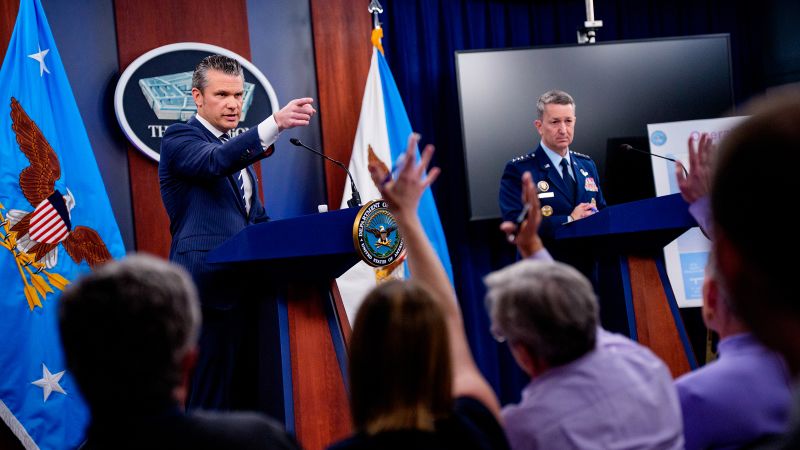On a significant Sunday morning, Defense Secretary Pete Hegseth and Chairman of the Joint Chiefs of Staff Dan Caine stood in the Pentagon briefing room to announce one of the most pivotal military actions during President Donald Trump’s administration. This operation, known as Operation Midnight Hammer, was presented as a groundbreaking success, with Hegseth praising it for having “devastated the Iranian nuclear program” and asserting that it effectively incapacitated capabilities at the Fordow nuclear facility. He emphasized the strategic success of the mission as part of a choreographed moment orchestrated for media visibility, complete with the symbolism of a pressed American flag pocket square.
Caine, donned in full military uniform, took a decidedly different tone. His remarks were deliberate and carefully detailed, as he mapped out a timeline for the strikes targeting Iranian nuclear infrastructures. Caine urged a calculated patience, acknowledging that the full scope of the operational damage was still under assessment. This showcased a clear contrast in presentation and style between him and Hegseth, highlighting what sources have described as a fundamental divergence in approaches between the two military leaders.
Trump, known for his appreciation of theatricality and striking public appearances, has consistently claimed the importance of having high-profile officials who fit a certain image—essentially, those who come straight from “central casting.” Hegseth, who transitioned from a television anchor at Fox News to the role of Defense Secretary, has visibly influenced Trump’s decision-making on military involvement, especially following a difficult initial period characterized by scandals and staff upheaval during his early months in the role.
Conversely, Caine has been regarded as a quiet yet steadfast adviser in the shadows, demonstrating competencies that Trump seemed to value when faced with momentous decisions. Caine’s allegiance and strategic counsel were apparent as Trump contemplated significant military options concerning Iran’s nuclear program; he had become an integral part of the small advisory circle that informed the president during critical decision-making moments.
General Michael Kurilla, who leads U.S. Central Command, also proved to be a key figure in shaping Trump’s perspectives on military engagements in the Middle East, joined by CIA Director John Ratcliffe and special envoy Steve Witkoff. He efficiently steered discussions on Iran, contrasting sharply with Hegseth’s more cautious viewpoints regarding U.S. military expansion overseas. Former and current officials noted that Hegseth often deferred to Kurilla’s guidance, leading to friction with more non-interventionist elements within Hegseth’s inner circle.
As the U.S. Central Command sensed a heightened urgency regarding Iran’s nuclear ambitions, the discussions revolved around the rapid pace at which Tehran could potentially attain a usable nuclear weapon, leading to an increasingly dire assessment. This tension played out in real-time discussions, such as those at Camp David, where top officials were mapping out options for possible U.S. actions, with Trump frequently leaning more towards the insights of Caine and Kurilla rather than Hegseth.
Despite being present in critical national security discussions, Hegseth began to cultivate a reputation for being primarily concerned with aligning with Trump’s directives. Insiders noted that he often chose to avoid confrontation over differing opinions unless it coincided with the president’s desires. Hegseth’s involvement in military actions reached a new benchmark when he recommended a decisive strike to the president on behalf of the administration, a call of which President Trump approved just before acting.
Subsequently, as Operation Midnight Hammer drew to a close, Hegseth’s visibility in the operational context contrasted sharply with his earlier, tumultuous tenure. Previously embroiled in controversy due to leaks regarding military options against the Houthis in Yemen, he faced skepticism regarding his operational security. Criticism regarding perceived chaos at the Pentagon among frontline operators led to a significant self-evaluation within Hegseth’s team.
However, following the success of Operation Midnight Hammer, military analysts commended Hegseth for his operational integrity and the absence of leaks, marking him as a prominent figure responsible for the successful execution of the strikes. His stature was further solidified as he stood shoulder-to-shoulder with Trump during a key address to the nation, flanked by influential figures like Vice President JD Vance and Secretary of State Marco Rubio. In his public statements at the Pentagon, Hegseth attributed the mission’s success to Trump’s “bold and visionary leadership,” thereby emphasizing a renewed commitment to national security and U.S. military deterrence on the global stage.
CNN reporting, contributed to by both Kevin Liptak and Haley Britzky, elaborated on the complexities surrounding military operations, offering insight into the people and decisions that shaped this momentous occasion in U.S. history, underlining the evolving dynamics within the Trump administration.



